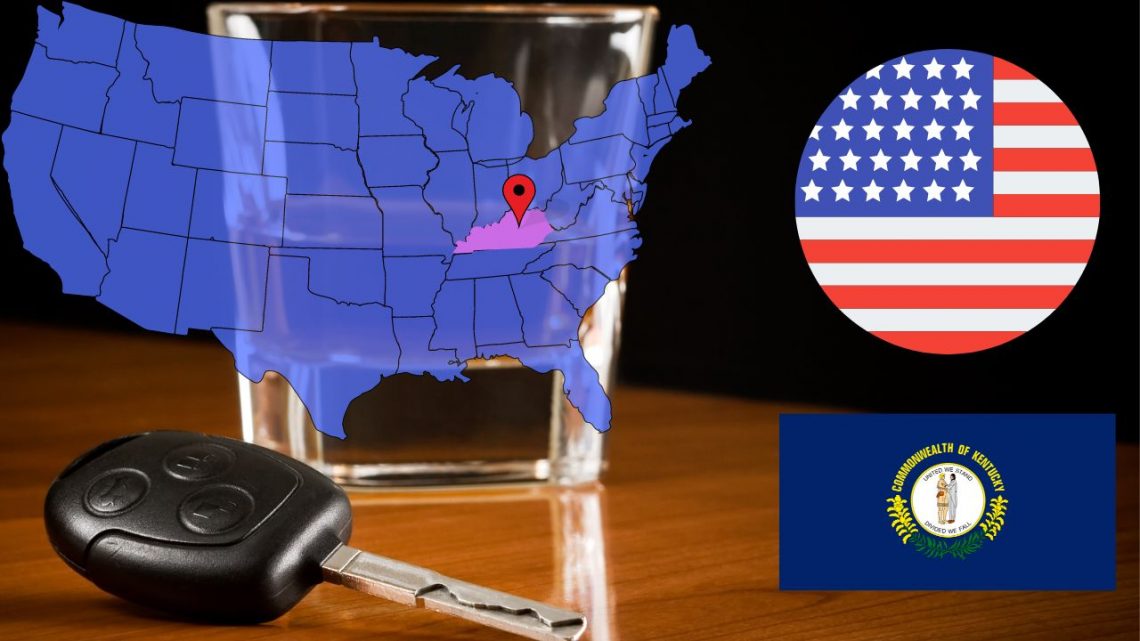In Kentucky, the legal limit for blood alcohol concentration (BAC) is set at 0.08%, equivalent to 80 milligrams of alcohol per 100 milliliters of blood.
It is essential to understand that this post was created to inform readers about Kentucky’s drunk driving laws before we continue our discussion of impaired driving. This article is not meant to support or encourage driving while intoxicated.
What is the legal alcohol limit for driving in Kentucky?
In Kentucky, the legal alcohol limits for driving vary depending on the type of driver’s license and the driver’s age. Here’s a breakdown of the specific blood alcohol concentration (BAC) limits for each category:
- Regular Drivers: The BAC limit is 0.08%. This applies to most drivers operating personal vehicles.
- Commercial Drivers: For those holding a commercial driver’s license (CDL), the BAC limit is lower, set at 0.04%, reflecting stricter standards due to the nature of their driving responsibilities.
- Minors (Under 21): Kentucky enforces a zero-tolerance policy for underage drinking and driving. It is illegal for minors to drive with any detectable amount of alcohol in their system.
Drink and Drive Penalties and Punishments in Kentucky
In Kentucky, the consequences for driving while intoxicated (DWI) or under the influence (DUI) of alcohol or any substance that impairs driving ability are severe. These substances can include illegal drugs, prescription medications, over-the-counter drugs, and inhalants such as glue, gasoline, or spray paint. Here’s what you need to know about DUI penalties and the importance of staying informed through the official state’s website.
DUI Penalties
Following the implementation of SB 85 on July 1, 2020, DUI suspension periods in Kentucky have been standardized. Previously, courts had the discretion to select suspension durations from a specified range based on the offense. Now, the Kentucky Transportation Cabinet (KYTC) administers fixed suspension times based on the type of conviction. Here are the specifics:
1st Offense within a 10-Year Period:
- 90 days of alcohol or substance abuse program
- 6-month license suspension
2nd Offense within a 10-Year Period:
- One year of alcohol or substance abuse treatment
- 18-month license suspension
3rd Offense within a 10-Year Period:
- One year of alcohol or substance abuse treatment
- 36-month license suspension
4th Offense within a 10-Year Period:
- One year of alcohol or substance abuse treatment
- 60-month license suspension
Commercial Driver’s License (CDL):
- A DUI conviction in any vehicle results in a one-year suspension for commercial drivers. A $50.00 reinstatement fee is required, along with passing written and vision tests before restarting with a permit. After a 14-day commercial learner’s permit period, passing all applicable skills tests is required to obtain a commercial license.
Refusal to Take Alcohol or Subsequent Tests:
- Refusing to submit to testing results in a suspension period equal to what would have been applied upon conviction.
Approved Alcohol Treatment Programs:
- Only completions from authorized DUI treatment programs are accepted. For a list of approved programs, visit the Program Directory and select Driving Under the Influence from Other Providers.
For DUI courses in other states, contact the Division of Driver Licensing at (502) 564-1257.
Kentucky Ignition Interlock Program (KIIP):
- Participation in KIIP can reduce suspension periods for eligible individuals. This requires operating only vehicles equipped with a functioning ignition interlock device. Suspension times can be reduced significantly with violation-free participation in KIIP.
Suspension Reductions Through KIIP Participation:
- 1st Offense: Up to a 4-month suspension with 90 days of program and KIIP participation.
- 2nd Offense: A 12-month suspension can be reduced with one year of program and 120 days of KIIP participation.
- 3rd Offense: An 18-month suspension can be reduced with the same requirements as the second offense.
- 4th Offense: A 30-month suspension is possible with one year of program and 120 days of KIIP participation.
It’s crucial to stay updated on DUI laws and penalties, as they may change. Always check the official Kentucky state website for the most current information.
How Can I Calculate If My Alcohol Blood Limit Is Legal in Kentucky?
In Kentucky, determining whether your blood alcohol concentration (BAC) is within the legal limit is crucial for safe and lawful driving. Law enforcement officers in Kentucky typically identify BAC levels through breathalyzer tests during traffic stops or sobriety checkpoints. These tests are designed to measure the alcohol concentration in your breath, which is then used to estimate the amount of alcohol in your blood.
As a former phlebotomist with a decade of experience, I can recommend two reliable methods to check your BAC level:
- Use a High-Quality Alcohol Breathalyzer: For those looking for a dependable way to measure their BAC, the BACtrack S80 is an excellent choice. It stands out due to its professional-grade accuracy and is both DOT & NHTSA approved and FDA 510(k) cleared. I strongly advise keeping one of these devices in your car. It’s common for people in Kentucky to misjudge their level of impairment, and having immediate access to a reliable breathalyzer can prevent the risk of driving while over the legal limit.
- Utilize a BAC Calculator: Together with a team of phlebotomists and web developers, I have developed an online BAC calculator. This tool is designed to help you estimate your BAC level based on the quantity and type of alcohol consumed, your weight, and the time frame over which you’ve been drinking.
It’s important to remember that while both these methods can provide you with a general understanding of your BAC level, they are not 100% accurate and should not be solely relied upon for determining your ability to drive legally. Factors such as metabolism, food intake, and individual health conditions can influence your actual BAC and how you process alcohol.
Therefore, if you find yourself questioning whether your BAC is over Kentucky’s 0.08% limit, it’s safer to opt out of driving. These tools can provide valuable guidance and potentially prevent you from making the dangerous decision to drive under the influence.
Ways to Avoid Driving with a High BAC in Kentucky

Driving with a high blood alcohol concentration (BAC) is not only illegal but also extremely dangerous for you, your passengers, and others on the road. Fortunately, there are convenient and safe alternatives to driving if you’ve consumed alcohol in Kentucky. Here are some recommendations to ensure you make it home safely without risking a DUI:
- Utilize Rideshare or Taxi Services: Technology has made it easier than ever to avoid driving under the influence. Apps like Uber and Lyft offer a reliable and quick option for getting a ride at the tap of a button, virtually anywhere in Kentucky. For those who prefer traditional taxi services, local companies are readily available. In Louisville, you can reach out to All Star Taxi LLC for dependable service. In Lexington, Lexington Express Cab offers timely rides. These services are particularly useful for nights out, events, or situations where alcohol consumption is involved.
- Order a Designated Driver Service: If you find yourself in a situation where you’ve driven to a location and consumed alcohol, leaving your vehicle behind might not be your preferred option. In such cases, designated driver services are a lifesaver. These services provide a driver to take you and your car home. In Louisville, Executive Transportation System offers such services, while AmRide operates in Lexington. To find a designated driver service in your area, a quick Google search for “designated driver service” along with your city’s name will provide you with options.
These alternatives not only help in avoiding the risk of a DUI but also play a crucial role in ensuring the safety of everyone on the road. It’s always better to plan ahead and consider these options before you start drinking. Keeping these services in mind and having their apps or phone numbers readily accessible can make the decision much easier when it’s time to head home. Remember, the cost of a ride home is always cheaper than the cost of a DUI, both financially and in terms of human safety.
Sticking to DUI Laws in Kentucky: Sad Statistics
Driving under the influence of drugs or alcohol is illegal in Kentucky, where 780 fatal accidents in 2020 were linked to drunk driving, with 26% involving BAC levels above 0.08%. Despite efforts to curb this issue, it remains a significant concern.
Before driving, familiarize yourself with Kentucky’s legal BAC limits and DUI laws. If you’ve consumed alcohol, consider alternatives like designated drivers, Uber, or taxis.
For the latest DUI laws, visit Kentucky’s official website. Drunk driving poses serious risks, and it’s crucial to avoid it. Never assume you’re safe to drive after just a few drinks. If in doubt, use a breathalyzer to check your BAC, and always opt for safer transportation options to prevent DUI incidents.







